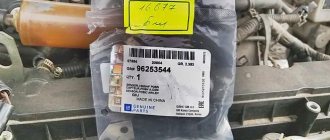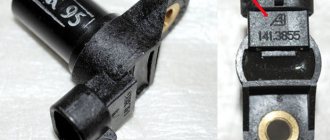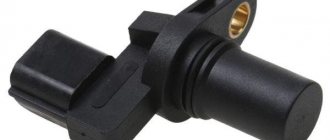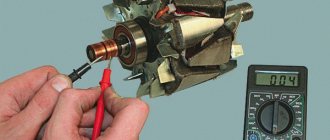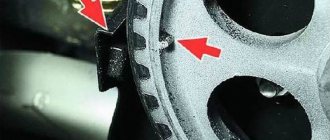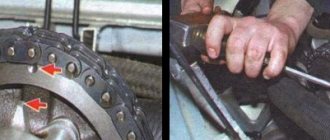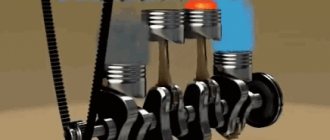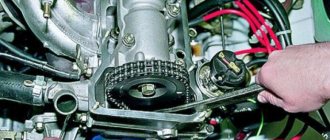The VAZ 2114 camshaft sensor is one of the most important measuring instruments of the fourteenth, which, through a pulse signal, transmits information about the current engine operating cycle to the car’s brains. Based on the information received, the electronics adjusts the timing of supply and ignition of the fuel mixture in the engine cylinders.
A normally functioning DF is the key to the correct functioning of the engine, which achieves the optimal ratio of the amount of fuel consumed and the operating power of the power unit.
From this article you will learn the main causes of DF malfunction and how the failure of the device affects the operation of the car. The technology for replacing the DF on the VAZ 2114 will also be examined in detail.
Features of the VAZ 2114 phase sensor
You can determine that the phase sensor on a VAZ 2114 has failed by the following malfunctions in the vehicle:
- Gasoline consumption has increased significantly;
- The acceleration dynamics of the fourteenth have worsened, and dips are observed in the engine’s idle speed;
- The engine idles;
- Errors No. 0343 and 0340 are displayed on the on-board computer screen, which indicate that the DF is faulty and the ECU is operating in emergency mode.
The reason why the phase sensor failed can be determined only after dismantling and visual inspection of the device, in some cases - after diagnosing it. As a rule, the main causes of DF failure are as follows:
- A short circuit has occurred on the internal DF circuit;
- Mechanical damage to the device mounting ears, due to which the housing has shifted in the mounting socket;
- The toothed disk on the pulse signal converter has broken;
- The DF was damaged due to the increased temperature of the engine.
PHASE sensor
If the device breaks down, the ECU starts working exclusively on the readings of the crankshaft sensor. In this mode of operation, it is impossible to carry out phased fuel injection, as a result of which the brains of the fourteenth switch the engine to twin injection, which results in excessive consumption of gasoline and deterioration in acceleration dynamics.
Repairing the device in most cases is not advisable, since a DF that has once failed is unlikely to work normally in the future.
Fortunately, the cost of DF is low - the price of a new device is 400-600 rubles, depending on the manufacturer (prices are also relevant for sensors on the VAZ 2115).
If typical signs of DF failure occur, or if errors 0343 or 0340 are displayed on the on-board computer of the fourteenth, it is necessary to check the functionality of the DF. This is done using a conventional multimeter.
Fourteeners with 16 and 8 valve engines have different DFs, so the specifics of checking them will be slightly different.
How to check the camshaft sensor VAZ 2114 8v:
- On the first probe of the tester we set the voltage to 13.5 Volts and connect it to contact “E” on the DF, on the second probe, which must be connected to contact “B” - 0.9 V;
- Having closed the contacts, we bring a metal screwdriver to the end of the sensor. If the DF is working properly, you will see on the tester screen that the voltage of contact “B” has dropped to 0.4 Volts. If this does not happen, the DF is broken;
How to check the camshaft sensor VAZ 2114 16v:
- We set the following voltage on the multimeter: contact “E” – 13.5 Volts, “B” – 0.4 Volts;
- We close the contacts and insert a screwdriver into the hole on the phase sensor. If the device is working properly, the voltage at pin “B” will increase to 0.9 Volts.
A multimeter is a standard device for checking the performance of any sensor.
Having determined that the DF is faulty, you can begin to replace it. The process is easy enough that you will only need a ratchet wrench with a 10 mm head to do all the work yourself.
First, let's figure out where the VAZ 2114 phase sensor is located. It is located on the right side of the engine compartment, near the air filter. It is secured to the cylinder block body with one screw.
Replacement of the VAZ 2114 phase sensor is carried out in the following sequence:
- Open the hood and disconnect the power terminals from the fourteenth battery;
- Disconnect the wire block from the DF;
- Using a 10mm wrench, unscrew the screw fixing the sensor on the cylinder block;
- We remove the DF from the mounting socket.
After dismantling the old device, inspect it visually; perhaps the cause of its malfunction is metal dust magnetized on the DF body. If found, wipe the device with a cloth and reinstall it. If it does not come to life and the on-board computer continues to generate errors, the sensor needs to be replaced.
The new camshaft position sensor of the VAZ 2114 is installed in a similar way. As you can see, the work here only takes 10-15 minutes (replacing the VAZ 2115 phase sensor is carried out using the same method).
Important: when installing the DF into the mounting socket to seal the fixation, it is prohibited to use any sealing agents, since the device is located in an environment with a constantly changing temperature regime, in which the sealant will simply melt and bring you a bunch of additional troubles with the engine.
There are often cases when, even after installing a new DF, errors 0350 or 0343 continue to be displayed on the on-board computer of the fourteenth.
There are two possible scenarios for the development of events. You may have come across a faulty DF (even salespeople in auto stores say that if for 10 domestically produced phase sensors there are 5 workers, without manufacturing defects, this is already good).
Checking the functionality after replacement is carried out using a multimeter, as described in the previous section of the article. If the tester data corresponds to the indicators of a fully working sensor, then the problem is not with it. Errors 0350 and 0343, indicating a faulty DF, can also occur due to a timing belt that is stretched or has slipped by 1-2 teeth, or a loose crankshaft gear.
In this article we will tell you about the location of the camshaft sensor, list the main symptoms of its failure, and also tell you how you can check this part yourself and replace it.
This sensor is necessary so that the control unit can determine the position of the pistons and correctly adjust the ignition timing. The sensor has an electronic communication with the ECU. To determine where the camshaft sensor is located on a VAZ 2114, it is necessary to inspect the power unit in the area of the air filter.
Where is the camshaft sensor located on the VAZ 2114?
The part is installed on both 8 and 16 valve engines. The main difference is the number of timing shafts. The camshaft sensor on the VAZ 2114 is located at the top of the engine next to the air filter .
This location is due to the operating principle of the sensor. During operation of an internal combustion engine, the camshaft rotates constantly. The operating principle of the phase sensor is based on an electromagnetic field.
A specialized gear is installed on the camshaft. In one place it has two missing teeth.
At the moment the control point coincides with the place where the camshaft sensor is located on the VAZ 2114, the piston of the first cylinder is located at TDC or BDC. In this case, an electrical signal is sent to the electronic control unit. This is how the ECU controls the position of the pistons at a certain point in time.
Location and purpose
To detect the phase sensor, you do not need to take complex acrobatic positions, it is not difficult to get to it, it is located where the camshaft is located, on the right side of the engine compartment near the air filter. Moreover, it doesn’t matter at all whether there are 8 valves or 16 in your “iron horse”, the registration address “DPRV” remains unchanged. So how does this small, seemingly useless mechanism work? Having learned its specialization, doubts about its effectiveness will disappear on their own.
So, the phase sensor, with the assistance of a special gear, reads information from the camshaft, and then sends it to the electronic engine control unit. The latter, based on the data received, adjusts the ignition angle. That is, dear friends, we happy owners of the “fourteenth model” do not need to constantly adjust the trampler, as happens on carburetor cars, everything is automatic here. What can we say, the 21st century is truly a time for new technologies. It is thanks to this process that it is possible to significantly reduce fuel consumption, and even increase the power level of the power unit. Just imagine how much a fuel-injected car would eat without DPRV?
Symptoms of malfunction
The vehicle owner can independently determine the failure of a part. Incorrect operation of the device leads to deterioration in engine power and the appearance of other symptoms such as:
- Difficulty starting the power unit, regardless of its heating temperature. When you try to start the engine, the time it takes for the flywheel to spin up with the starter increases.
- Incorrect engine operation at idle. Lack of stability, floating speed. Due to lack of information, the electronic control unit cannot select the correct ignition timing. Car owners note the lack of stability in the operation of the power unit.
- Deterioration in response to pressing the accelerator pedal. Reduced dynamic performance of the vehicle. The symptom is especially noticeable when changing gears; there is a failure.
- Spontaneous stopping of the power unit at idle speed.
- Gasoline consumption increases significantly. Incorrect operation of the gas distribution mechanism and the lack of information supplied to the control unit make it impossible to correctly select the air-fuel mixture.
If the above symptoms appear, you should check the performance of the DPRV and, if necessary, replace it. Particular attention should be paid to checking the electrical wiring.
In some cases, the reason for the lack of information transmitted to the control unit may be a broken wire or oxidation of the connectors.
How to check the phase sensor?
If the outer part of the DPRV does not have visible mechanical damage, it is necessary to remove it from the car and check it with a multimeter.
Diagnostic measures are performed in the following order:
- Dismantling the device. In order to remove the part, disconnect the electrical connector, unscrew the fastening nut and remove the part from the installation site. For dismantling, use a socket wrench or a 10mm socket.
- The tester is set to DC voltage measurement mode. To carry out measurements, select a range of up to 20 volts.
- Measure the voltage at the negative and positive contacts of the electrical connector. To do this, turn on the ignition. When checking, there should be voltage on the contacts.
- Connect the positive and negative contacts of the part to the on-board network. The voltage coming from the battery must be measured. The norm is considered to be 12-14 volts.
- The tester probes are connected to the positive and signal contacts. For convenience, you can use specialized clamps. After connecting the part, the voltage on the multimeter should be at least 90% of that coming from the battery.
- Bring a metal product to the working part of the device. When holding the metal plate, the reading on the tester display should drop to 0.4 V.
If during the diagnostics it was possible to determine that the part is working, then the electrical wiring should be checked for integrity. If necessary, clean oxidation from the contact pads of the connectors. If the indicators deviate during the measurement process, the product will need to be replaced with a new part.
Replacing the camshaft sensor on an 8 valve VAZ 2114
- Disconnect the negative terminal from the battery.
- Disconnect the electrical connector of the sensor.
- Unscrew the fastening element.
- Remove the product from its seat.
Installation of the new part is carried out in the reverse order. After installation, it is necessary to start the engine and check the operation of the phase sensor.
Many motorists have encountered the fact that the camshaft sensor, or in other words, the VAZ-2114 phase sensor, has failed. There can be many reasons for this phenomenon, but as a rule it is wear and tear. Not all car enthusiasts are able to diagnose this sensor, although there is nothing complicated or abstruse in the process itself.
Video review of the symptoms of a camshaft sensor failure on a VAZ-2114:
Literature on operation and repair
| 1 | Reviving a VAZ 2113, 2114, 2115 car on the road. | 2007 | 49 pp. | Size - 1.71 MB | Format - djvu |
| 2 | OPERATING INSTRUCTIONS FOR CAR VAZ-2113, -2114, -2115 AND THEIR VERSIONS | 2002 | 88 pp. | Size - 751 KB | Format - pdf |
| 3 | Structures of split gasoline injection for VAZ cars - design and diagnostics | 2003 | 128 pp. | Size - 1.67 MB | Format - pdf |
| 4 | LIST OF COMPONENTS AND ASSEMBLY PARTS VAZ 2113, 2114, 2115 | 2010 | 266 pp. | Size - 6.37 MB | Format - pdf |
| 5 | VAZ 2113, 2114, 2115 - Manual on maintenance, maintenance, restoration and tuning | — | 240 pp. | Size - 29.31 MB | Format - pdf |
Operating principle of the sensor
General view of the camshaft sensor
The camshaft sensor or phase sensor is a part of the main power unit of the car, which is responsible for reading information about the location of the camshaft and is also involved in adjusting the ignition angle.
This meter is similar in principle to a Hall sensor .
Reading occurs using a special camshaft gear that has no teeth. The missing elements are located in such a way that when this gap hits the sensor, the first piston is at the dead center, at the top or bottom.
Phase sensor operation diagram
A signal is triggered and transmitted to the engine's electronic control unit when the sensor hits the missing teeth. In turn, depending on the received indicator, the ECU adjusts the ignition angle. Thanks to the installation of such a system, Samara-2 engines have become more efficient and popular.
Location of the sensor under the hood of the VAZ-2114
The camshaft sensor on the VAZ-2114 is located near the air filter, at a very close distance from the cylinder head. This meter location is almost always standard for other cars in the injection group.
Camshaft sensor location
The main reasons for sensor failure
Before proceeding directly to the diagnostic process, it is necessary to find out the causes of the malfunction of the VAZ-2114 phase sensor.
So, let's move directly to the most direct and indirect indicators:
Electrical circuit of the sensor
- Check Engine on the dashboard indicates that a malfunction has occurred. In this case, the engine starts without waiting for a response from the camshaft sensor, and the ignition system works based on the latest indicators.
- Increased consumption of the fuel mixture can also serve as an indirect indicator of a malfunction of the air flow control valve.
- The car begins to lose power and dynamics as a whole.
The combination of these reasons can serve as an indirect indicator of a malfunction of the camshaft sensor.
Installation
1. Lubricate the camshaft journals with clean engine oil.
2. Place the camshaft in the cylinder head with the pin facing up.
3. Before installing the bearing housings, apply a thin layer of sealant to the mating surface of the block head in the areas of the front oil seal and plug.
4. Evenly, in several steps, tighten the nuts of the bearing housings until the housings come into contact with the cylinder head (following the sequence shown in the photo). Then tighten the nuts to a torque of 18.4-22.6 N m (1.9-2.3 kgf m).
5. Press in a new camshaft oil seal (see “Camshaft oil seal - replacement”).
Sequence of tightening the bearing housing nuts
6. Before installing the plug, put the O-ring on it.
7. Further assembly is carried out in the reverse order of removal.
Checking the operation of the camshaft sensor
So, when all the questions have been considered, you can proceed directly to diagnostic operations.
The first method is manual diagnostics . How is it carried out? Let's consider this issue step by step:
- We dismantle the sensor.
- The first diagnosis is visual.
It is worth inspecting the condition of the case, the presence of damage and cracks. Sensor wire pinout
Multimeter to help
Now you need to check the contact group using a multimeter. First, we inspect the contacts for the presence of moisture, and then “ring” them. If the tester does not respond, then the sensor is faulty.
Diagnostics is carried out as follows: the “minus” probe of the tester is connected to the left contact on the sensor, and the “plus” to the central one. Next, we bring the metal plate to the sensor. A change in the voltage reading on the sensor will be immediately visible on the multimeter.
Checking the sensor using a multimeter
The second diagnostic method is to connect to the vehicle's electronic control unit. In it, when the Check Engine appears, error codes remain that indicate a malfunction. There are two errors associated with the phase sensor, namely:
- FAZ sensor error 0340 - shows that the ECU does not receive a signal from the camshaft sensor. You should check the breakage and condition (oxidation) of the contacts before damaging the sensor itself.
- Error 0343 - high signal level of the camshaft sensor.
Most often this is damage to the wiring from the ECU to the sensor, or breakage and oxidation of the terminals, or an unreliable connection. Working principle of the camshaft sensor
Oscilloscope
The third method of diagnostics is an oscilloscope. Using this device, you can almost immediately determine whether the camshaft sensor is faulty. But, unfortunately, not every car enthusiast has this device in his arsenal.
Checking with a computer or oscilloscope
Signs of device failure
A faulty phase sensor will result in signal disruption. The ECM polls the DF for 4-5 minutes. If the signal does not appear within the specified period, the unit switches to double fuel injection mode.
If the phase indicator fails, the controller queries only the crankshaft position sensor. In this case, gasoline is supplied simultaneously to two cylinders. At the same time, fuel consumption increases by approximately 10%.
Failure of the phase sensor leads to a number of other troubles. Repairs need to be made. Signs of engine trouble:
- Increased gasoline consumption.
- Vehicle diagnostic failures.
- Violation of acceleration dynamics of VAZ 2115.
- Difficult start. The engine starts after 4-5 seconds.
- After starting, the Check Engine light comes on.
- Error P0343 or 0340 appears during diagnostics.
Before inspecting the sensor, you should make sure that the remaining parts are in good condition. Failures will occur due to a broken timing belt, loose camshaft gear, or incorrect installation of marks.
Often sensor error 0343 is associated with oxidation of contacts or broken wires. Before discarding the phase indicator, make sure the wiring is intact. Resistance measurements in the circuit are carried out with a multimeter.
It is difficult to determine the malfunction of the phase sensor yourself. It is better to carry out diagnostics at a service station. The sensor is checked on a computer.
If the auto mechanic makes a disappointing diagnosis, then we go to the store. You should know that you can run into low-quality spare parts or fakes. Experts advise purchasing sensors from Bosch or the Kaluga plant.
The phase sensors for 8- and 16-valve engines are different. Therefore, when purchasing, tell the seller your engine type. The best option would be to go to the car market with your original. If after replacement the sensor error occurs again, return it.
conclusions
Checking the camshaft position sensor of the VAZ-2114 is quite easy and simple. Almost every motorist can cope with this task. But, it is still recommended to start diagnostic operations by connecting to the ECU and identifying error codes.
The VAZ 2114 car is equipped with a phase sensor. It is necessary to determine the position of the camshaft in relation to the parts of the crank mechanism. Symptoms of a malfunction of the phase sensor on a VAZ 2114 8 valves may differ individually for each case, and in this article we will consider all possible manifestations of this malfunction.
Repair price
If you check and remove the DF yourself, under such conditions the motorist will only have to spend money on purchasing a new DFSV. This device, namely the camshaft position sensor for the VAZ 2114, will cost around 300 rubles. When purchasing a position regulator, pay attention to the quality, because parts from certified stores for VAZ are best suited. If the driver wants to entrust his car to service station specialists, such repairs will cost at least twice as much. In any case, the decision will be made by the owner of the car.
Thus, if the driver has skills in working with hand and power tools, and also knows the design features of the VAZ 2114, he can painlessly dismantle and repair the camshaft sensor. Despite its modest size and ease of operation, the DPRV is an important component of the machine, which affects its power and driving performance. If the driver wanted to make the repairs himself, he should stock up on the necessary tools.
Signs of a faulty phase sensor on a VAZ 2114
Checking the phase sensor of a VAZ 2114 with an 8-valve engine is possible using a multimeter. Signs of a malfunction may vary from person to person. Most often, failure of the DPRV is manifested by the following symptoms:
- Difficulty starting the engine, regardless of its temperature. This is due to the formation of an incorrect composition of the air-fuel mixture.
- Incorrect operation of the power unit at idle. Car owners note the lack of stability in the operation of the power unit at idle. This symptom is explained by the fact that the electronic control unit, due to the lack of data from the DPRV, cannot correctly select the ignition timing.
- Slow response to pressing the accelerator pedal. Reduced dynamic performance of the vehicle. The symptoms are due to the fact that the electronic control unit has selected the wrong air-fuel mixture. The symptom is especially noticeable when shifting to a higher gear.
- Fuel consumption increases significantly. Incorrect operation of the gas distribution mechanism and the lack of information supplied to the control unit make it impossible to correctly select the air-fuel mixture. Supplying a large amount of gasoline leads to excessive consumption.
- Spontaneous stopping of the power unit at idle speed. This is especially common when the engine is not warmed up. This indicates that the ECU has selected the air-fuel mixture too lean.
- There is a dip when you press the gas pedal sharply. The ignition timing is incorrectly adjusted.
The vehicle owner can independently determine the failure of the DPRV based on the above signs. If symptoms appear, replace the part with a known working part. In some cases, it may be necessary to additionally check the functionality of the wiring.
Signs of DPRV failure
There are several typical signs that indicate that the camshaft position sensor has failed. It is immediately necessary to clarify that the symptoms listed below may indicate completely different malfunctions. Therefore, it makes sense to perform additional diagnostics. So, signs of a DPRV breakdown:
- Problems with starting the engine, under any conditions - “cold”, “hot” and in other modes. This usually results in having to crank the starter longer.
- Unstable engine operation, “floating” operating and idle engine speeds.
- “Dips” in the movement of the car; when you press the accelerator pedal, it does not respond immediately, the dynamic characteristics of the car are lost (it accelerates poorly, does not pull, especially when loaded and when moving uphill).
- When the accelerator pedal is released, the engine stalls.
- Increased fuel consumption (by 10...20%).
- The Check Engine warning light on the instrument panel activates. It is necessary to perform additional diagnostics using an electronic scanner (for example, an ELM 327 device or its equivalent). In this case, typical errors regarding the operation of the sensor are numbers P0340, P0342, P0343.
In fact, the camshaft position sensor is a fairly simple and reliable device, so it rarely fails. More often, its wiring is damaged - the wires fray, the insulation on them is damaged, the so-called “chip”, the place where the sensor is connected to the car circuit, fails.
However, for cars that run on gasoline, the problems described above are not so clearly expressed. But a failed camshaft position sensor will cause many problems for owners of cars equipped with gas equipment, in particular the fourth generation. The malfunctions and problems described above can appear on such machines “in all their glory.” Therefore, owners of cars equipped with HBO are strongly recommended to diagnose and replace the sensor as quickly as possible if it is suspected of being faulty.
How to check the phase sensor on a VAZ 2114?
Before checking the VAZ 2114 phase sensor with a multimeter, you must first inspect the part for damage. If there is visible mechanical damage to the product body, it must be replaced with a known working one. If there are no cracks or chips, diagnostics are carried out in the following order:
- Remove the phase sensor from the car. To do this, disconnect the electrical connector and unscrew the fasteners securing the products in the seat. To speed up the process, you can use a ratchet head.
- The multimeter switch is set to DC voltage measurement mode. For testing, select a range of up to 20 volts.
- Measure the voltage at the positive and negative contact pads of the electrical connector. With the ignition on, the multimeter should show the presence of constant voltage.
- Connect the positive and negative contacts to the battery. At the same time, the voltage applied to the part is measured. It should be between 12-14 volts.
- The multimeter is connected to the positive and signal pads, and readings are taken. The voltage between the positive signal contact must be at least 90% of the supply voltage.
- Bring a metal plate to the working surface of the part. As the plate approaches, the voltage should drop to 0.4 volts.
If during diagnostics it turns out that the DPRV has failed, it must be replaced with a new sensor. Otherwise, you should pay attention to the integrity of the electrical wiring. If necessary, clean the connector pads from oxidation.
Product replacement
- Disconnect the on-board power supply by removing the negative terminal from the battery.
- Disconnect the electrical wiring plug.
- Unscrew the fastening element.
- Remove the sensor from its seat.
- Install the new product in reverse order.
So, in this article we have listed the main symptoms of a faulty phase sensor on a VAZ 2114, talked about how you can check this sensor, and also described the process of replacing it. If you have any questions, be sure to ask them in the comments. We will try to help you help!
Sources used:
- https://autovaz-2114.ru/electrical-equipment-in-the-car/osobennosti-proverki-i-zameny-datchika-faz-vaz-2114-poshagovye-instrukcii/
- https://vaz-2114.info/gde-nahoditsya-datchik-raspredvala-na-vaz-2114/
- https://carfrance.ru/kak-proverit-datchik-raspredelitelnogo-vala-vaz-2114/
- https://vaz-2114.info/priznaki-neispravnosti-datchik-faz-na-vaz-2114-8-klapanov/
